Renovating Europe’s legacy building stock to improve its energy efficiency can deliver a vast cut in greenhouse gas emissions and boost the prospects for an economic recovery.
Buildings are responsible for 40% of the European Union’s energy consumption and 36% of its carbon emissions.
This means real estate will be a key focus for the European Commission’s "Fit for 55" package, which legally enshrines plans to cut greenhouse gas emissions by 55% from 1990 levels by 2030, and reduce them to net zero by 2050.
To put that in context, the aviation sector, which constantly steals the headlines, accounts for only 3%-4% of global greenhouse emissions. An individual would need to make a staggering 210 plane trips a year to equal the emissions produced by a single family home.
There are about 220m dwellings in Europe that, on average, require energy efficiency investments of €25,000-€30,000 to reduce their energy running costs by up to 50%.
Those numbers starkly illustrate not only the extent to which energy consumption could be cut, but also the massive impact this prospective spending could have on the economy.
But wait, there’s more.
The sums are particularly compelling for low income households, which spend a higher proportion of their income on energy bills.
This matters because it makes lending to these households a safer bet. And that means banks should need to allocate less precious capital to an energy efficient mortgage than to a vanilla one.
And that's not all.
Because lower income households have a higher propensity to spend, a larger proportion of their increased disposable income goes back into the economy.
In other words, the multiplier effect of energy efficient refurbishments on low income households not only does social good, it also saves the planet while helping to rev up real economic activity — as opposed to just asset prices, which is what years of quantitative easing seem to have achieved.
The European Mortgage Federation – European Covered Bond Council has been quietly working away behind the scenes for years, helping banks throughout Europe to hit several key milestones — from the origination of energy efficient mortgages through to their funding in the capital markets.
Transparency is at the heart of this drive. In this vein, the EMF-ECBC has developed a green or energy efficient mortgage label that usefully dovetails with EU Taxonomy Climate Delegated Act.
This means that banks which adopt the label can be sure they’ve met the EC’s Taxonomy standard and investors can be sure they’re buying something that has not been greenwashed.
The European Commission launched its Renovation Wave Strategy for improving the energy performance of buildings 12 months ago. With that, the renovation of existing housing stock stands to be at the centre of this decade’s growth strategy.
Mortgages invariably make up the largest component of assets on banks’ balance sheets, and green financing has to be a part of the strategic drive to cut global emissions.
The foundations of the European renovation revolution have been laid. Now is the time to get to work.

